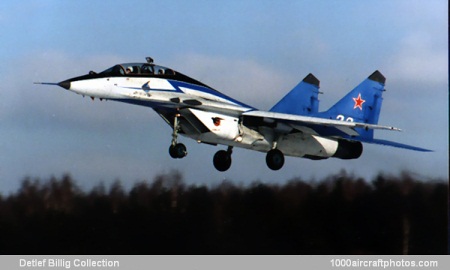12/31/2009. Mikoyan planned several two-seat versions, but the first variant to follow the basic MiG-29 was the MiG-29UB (uchebnyi boyevoy, trainer for combat). Virtually all the differences are confined in the forward fuselage. The pupil's cockpit, almost identical to the original, is in front at a significantly lower level.
The front windscreen is the same as for the MiG-29, and both cockpits are covered by a one-piece canopy hinged at the rear and powered up by a pneumatic ram. Both occupants have K-36DM seats; the instructor can eject the pupil but cannot disconnect his flight controls.
By removing the radar it was possible to hold the length of the fuselage within 4 in (100 mm) of the single-seater. All other sensors and weapons are fitted, and the pupil can practice simulated interceptions with the gun (usually 50 rounds only) and missiles (normal stores limit 5,071 lb, 2,300 kg).
Both occupants have rearview mirrors, those for the instructor being around a transverse frame around the canopy. In the top of the same frame is a folding wide-screen periscope, extended by lowering the landing gear, which improves the instructor's view ahead. Special equipment in the instructor's cockpit can simulate target information on the pupil's HUD sight or any of a range of in-flight emergencies.
The prototype was first flown by OKB pilot A.G. Fastovets on April 29, 1981. The series MiG-29UB was built only at Gor'kiy (the Sokol factory, now MAPO Nizhniy-Novgorod). All customers for the single-seater purchased a number, the total number built in 1985-91 being 197. Two, locally called MiG-29NUB, with Western avionics, were bought by Malaysia.
The aircraft belongs to the "Strizhi" (Swifts), an aerobatic team formed by pilots from the 237th Guards Proskurov Aircraft Demonstration Center based at Kubinka airbase. They flew their first display on May 6, 1991.
